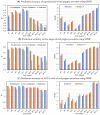Effect of Moisture Content Difference on the Analysis of Quality Attributes of Red Pepper (Capsicum annuum L.) Powder Using a Hyperspectral System
- PMID: 36553829
- PMCID: PMC9778110
- DOI: 10.3390/foods11244086
Effect of Moisture Content Difference on the Analysis of Quality Attributes of Red Pepper (Capsicum annuum L.) Powder Using a Hyperspectral System
Abstract
The variety of characteristics of red pepper makes it difficult to analyze at the production field through hyperspectral imaging. The importance of pretreatment to adjust the moisture content (MC) in the process of predicting the quality attributes of red pepper powder through hyperspectral imaging was investigated. Hyperspectral images of four types of red pepper powder with different pungency levels and MC were acquired in the visible near-infrared (VIS-NIR) and short-wave infrared (SWIR) regions. Principal component analysis revealed that the powders were grouped according to their pungency level, color value, and MC (VIS-NIR, Principal Component 1 = 95%; SWIR, Principal Component 1 = 91%). The loading plot indicated that 580-610, 675-760, 870-975, 1020-1130, and 1430-1520 nm are the key wavelengths affected by the presence of O-H and C-H bonds present in red pigments, capsaicinoids, and water molecules. The R2 of the partial least squares model for predicting capsaicinoid and free sugar in samples with a data MC difference of 0-2% was 0.9 or higher, and a difference of more than 2% in MC had a negative effect on prediction accuracy. The color value prediction accuracy was barely affected by the difference in MC. It was demonstrated that adjusting the MC is essential for capsaicinoid and free sugar analysis of red pepper.
Keywords: hyperspectral imaging; moisture adjustment; multivariate analysis; red pepper powder.
Conflict of interest statement
The authors declare no potential conflict of interest.
Figures









References
-
- Hwang S.Y., An Y.H., Shin G.M. A study on the quality of commercial red pepper powder. Korean J. Food Nutr. 2001;14:424–428.
-
- Ku K.H., Kim N.Y., Park J.B., Park W.S. Characteristics of color and pungency in the red pepper for Kimchi. Korean J. Food Sci. Technol. 2001;33:231–237.
-
- Choi S.M., Jeon Y.S., Park K.Y. Comparison of quality of red pepper powders produced in Korea. Korean J. Food Sci. Technol. 2000;32:1251–1257.
-
- Mo C.Y., Kang S.W., Lee K.J., Lim J.G., Cho B.K., Lee H.D. Development of prediction model for capsaicinoids content in red pepper powder using near-infrared spectroscopy-particle size effect. Food Eng. Prog. 2011;15:48–55.
-
- Kang J.H., Son H.J., Hong E.J., Noh B.S. Discrimination of grading pungency for red peppers spice using electronic nose based on mass spectrometer. Food Eng. Prog. 2010;14:35–40.
Grants and funding
LinkOut - more resources
Full Text Sources
Other Literature Sources
Miscellaneous

